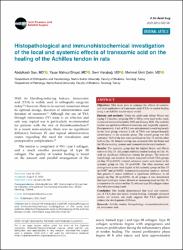| dc.contributor.author | Sarı, Abdulkadir | |
| dc.contributor.author | Dinçel, Yaşar Mahsut | |
| dc.contributor.author | Karabağ, Sevil | |
| dc.contributor.author | Çetin, Mehmet Ümit | |
| dc.date.accessioned | 2022-05-11T14:12:30Z | |
| dc.date.available | 2022-05-11T14:12:30Z | |
| dc.date.issued | 2021 | |
| dc.identifier.issn | 2687-4784 | |
| dc.identifier.issn | 2687-4792 | |
| dc.identifier.uri | https://doi.org/10.5606/ehc.2021.76301 | |
| dc.identifier.uri | https://hdl.handle.net/20.500.11776/5583 | |
| dc.description.abstract | Objectives: This study aims to compare the effects of systemic and local applications of tranexamic acid (TXA) on tendon healing using a rat Achilles tendon injury model. Patients and methods: Thirty-six adult male albino Wistar rats (aging 3-4 months; weighing 350 to 400 g) were used in this study conducted between December 2019 and January 2020. The Achilles tendon was performed bilateral tenotomy and surgically repaired. Postoperatively, 1 mL of TXA was administered to each leg locally in the local group, whereas 2 mL of TXA was intraperitoneally administered in the systemic group. The control group was left untreated. Half of the rats were sacrificed on Day 15 and the other half on Day 30. Tendon healing was evaluated with the Bonar and the Movin scoring systems and immunohistochemical methods. Results: The systemic group had the highest Bonar and Movin scores on Day 15. All groups exhibited tendon healing on Day 30, with no significant differences among the groups. The tenocyte morphology was found to be more impaired in both TXA groups on Day 30 (p=0.013). Ground substance scores were lower in the systemic group on Day 30 (p=0.028). The fiber structure and arrangement scores were higher in the systemic group on Day 15 (p=0.007 and p=0.032). Immunohistochemical analyses showed that galectin-3 values exhibited a significant difference in all groups on Day 30 (p=0.020). In all groups, it was determined that type I collagen values showed an increasing trend on Day 30, compared to the values on Day 15, whereas type III collagen values showed a decreasing trend. Conclusion: Our results demonstrated that local and systemic use of TXA does not impair tendon healing. Although advanced studies are needed, our study suggests that TXA application reduces the development of fibrosis. | en_US |
| dc.language.iso | eng | en_US |
| dc.publisher | Turkish Joint Diseases Foundation | en_US |
| dc.identifier.doi | 10.5606/ehc.2021.76301 | |
| dc.rights | info:eu-repo/semantics/openAccess | en_US |
| dc.subject | Achilles tendon | en_US |
| dc.subject | histopathology | en_US |
| dc.subject | immunohistochemical | en_US |
| dc.subject | rat | en_US |
| dc.subject | tranexamic acid | en_US |
| dc.subject | Risk | en_US |
| dc.title | Histopathological and immunohistochemical investigation of the local and systemic effects of tranexamic acid on the healing of the Achilles tendon in rats | en_US |
| dc.type | article | en_US |
| dc.relation.ispartof | Joint Diseases and Related Surgery | en_US |
| dc.department | Fakülteler, Tıp Fakültesi, Cerrahi Tıp Bilimleri Bölümü, Ortopedi ve Travmatoloji Ana Bilim Dalı | en_US |
| dc.department | Fakülteler, Tıp Fakültesi, Cerrahi Tıp Bilimleri Bölümü, Tıbbi Patoloji Ana Bilim Dalı | en_US |
| dc.authorid | 0000-0001-6576-1802 | |
| dc.authorid | 0000-0003-3416-5666 | |
| dc.identifier.volume | 32 | en_US |
| dc.identifier.issue | 1 | en_US |
| dc.identifier.startpage | 152 | en_US |
| dc.identifier.endpage | 161 | en_US |
| dc.institutionauthor | Sarı, Abdulkadir | |
| dc.institutionauthor | Dinçel, Yaşar Mahsut | |
| dc.institutionauthor | Karabağ, Sevil | |
| dc.institutionauthor | Çetin, Mehmet Ümit | |
| dc.relation.publicationcategory | Makale - Uluslararası Hakemli Dergi - Kurum Öğretim Elemanı | en_US |
| dc.authorscopusid | 57221924322 | |
| dc.authorscopusid | 55994580900 | |
| dc.authorscopusid | 56904163300 | |
| dc.authorscopusid | 57221927685 | |
| dc.authorwosid | Dinçel, Yaşar Mahsut/AAB-8340-2019 | |
| dc.authorwosid | sari, abdulkadir/ABH-3293-2021 | |
| dc.authorwosid | sari, abdulkadir/AAF-3143-2021 | |
| dc.authorwosid | çetin, mehmet ümit/AAA-4905-2022 | |
| dc.identifier.wos | WOS:000608440400022 | en_US |
| dc.identifier.scopus | 2-s2.0-85100129243 | en_US |
| dc.identifier.pmid | 33463431 | en_US |



















